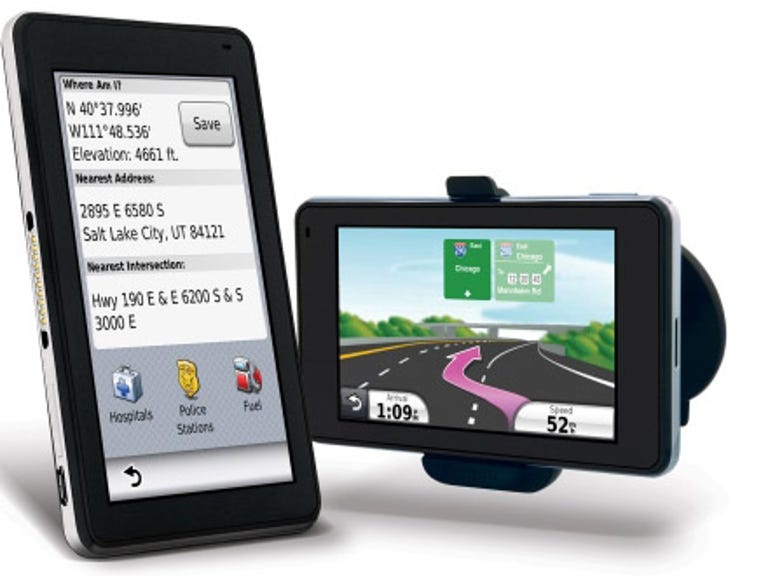 Why You Can Trust CNET
Why You Can Trust CNET Garmin Nuvi 3760 review: Garmin Nuvi 3760
Thin, light and clad in metal and glass, the Nuvi 3760 is the first portable nav device that's tugged on our heart as well as our mind. If you can, make the financial stretch to the 3790T as that model offers a brilliant voice recognition system.
Editor's note: We reviewed the Garmin Nuvi 3790T, which has more features than the otherwise identical 3760. The review below is an amended version of the 3790T's.
The Good
The Bad
The Bottom Line
Design
At the launch of the Nuvi 3700 series, the team from Garmin Australia brought a StreetPilot III model from 2001 for show and tell. Its roast beef-sized body, natty colour screen, scattershot approach to button placement and the new-found ability to discern roads from, well, everything else sat in stark contrast from the lithe and lovely Nuvi 3760.
We thought that the Navman MY500XT and the S300t before that were good-looking portable nav units, but the 3790T and its identical twin the 3760 socks it to them like a 29th second knock-out punch. The body is made from machined metal and not only feels fantastic to touch and hold but, weighing just 113g, somehow marries both lightness and rock-solid sturdiness.
With its 4.3-inch touchscreen, the 3760 is wider and taller than popular smartphones, such as the HTC Desire and Apple iPhone 4 — designs which, in many ways, it resembles. Without any cellular technology on-board, though, the 3760 is waif thin at 8.95mm.
As the 3760's touchscreen is capacitive in nature, it responds accurately to both presses and swipes, as well as multi-touch zoom. Graced with almost triple the number of pixels of a standard 4.3-inch GPS unit, the 800x480-pixel screen is not left wanting for sharpness and clarity, making it the second portable nav we've used that almost justifies itself inclusion of a picture viewing app. While its glossy glass screen makes colours pop, it is a magnet for both reflections and fingerprints, requiring both care with viewing angle and the cleaning cloth.
An accelerometer allows the unit to flip the screen between portrait and landscape modes, so you could conceivably use it on foot. There's a suitably loud but tinny speaker on the unit itself, as well as a powered speaker on the windscreen mount that's both loud and clear. It's a shame that although the mount does its job well, it's pretty much a standard ball-jointed Garmin affair and lacks the flair of the device itself.
Garmin's simple-to-use interface is largely unchanged: two large icons (Where To? and View Map) dominate the main menu and are underscored by smaller icons for settings, volume, Bluetooth phone connectivity and route modification. The map screen is clear and crisp, and thanks to a more powerful than usual brain animations are smooth and the map redraws quickly in nice little chunks. Neatly, the unit zooms out and changes perspective for distant manoeuvres and zooms back in for nearby turns.
Features
As Garmin's flagship GPS units for 2010, the Nuvi 3760 and 3790T come well specified. Common features include text-to-speech for spoken street names, lane guidance, junction view, Bluetooth hands-free, speed and red-light camera alerts, lane guidance, speed limit display, historical traffic information, and maps for both Australia (Whereis) and New Zealand.
The extra AU$100 investment required for the Nuvi 3790T nets the owner lifetime traffic information via the Suna network, voice control and activation, 3D buildings and terrain view. Neither unit comes equipped with an FM transmitter, MP3 playback or internet connectivity.
Bluetooth hands-free worked without a hitch on a number of phones, including the hot-to-trot Apple iPhone 4 and HTC Desire.
Like most recent Garmins, the 3760 features ecoRoute that attempts to get you to drive more economically via a host of visual aids, such as an on-map score and leaf display. At the time of writing, though, it doesn't support the ecoRoute HD Bluetooth dongle that plugs in a car's OBD-II port. On Garmin GPS units that support ecoRoute HD, drivers can view car diagnostic data and a wealth of sensor information, as well as more accurate fuel economy readings.
Performance
Equipped with Whereis' latest maps of Australia, there's lane guidance for most multi-lane roads and a junction view mechanism that primarily uses real-world photos, as opposed to somewhat unrealistic graphic renders.
By default historical traffic information, supplied by Suna and dubbed TrafficTrends by Garmin, is enabled. Routes generated with TrafficTrends are a mix of genius and sheer breathtaking stupidity; on the one hand it will avoid known bottlenecks, but on the other it will route you in circuitous routes, down unfriendly back alleys and across busy intersections without the aid of a set of traffic lights.
With TrafficTrends off (go to Tool > Settings > Navigation > Car > NuRoute) route calculation is at least 20 per cent faster on the 3790T/3760 than other Garmins and routing reverts back to the GPS norm of main roads, main roads and a few more main roads. Unlike many prior Garmins, tapping the power button puts the 3790T into sleep mode from which it can wake instantaneously.
GPS reception is fine in the suburbs and beyond, with the occasional drop out or confused position when surrounded by buildings that scrape the sky. The Nuvi's text-to-speech engine handles Australian pronunciation, as well as Aboriginal street names, pretty well.
Conclusion
A gorgeous piece of kit that works well, so long as you switch the TrafficTrends feature off. If you can, though, make the financial stretch to the top-of-the-range 3790T, as that model offers a brilliant voice recognition system.


